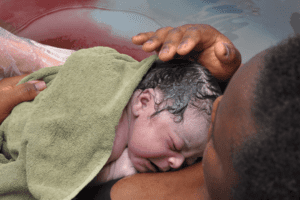What Could Happen to Your Skin During Pregnancy


Pregnancy changes all parts of a woman’s body, and the skin is no exception! Many of these conditions are related to the hormonal changes associated with pregnancy, and while some are just a nuisance, a few of these can actually make your pregnancy more high-risk.
Up to 90 percent of pregnant women will notice darkening of some part of their body, whether it be the areolae, labia, linea nigra (a dark line from pubic hair to belly button), or face. Many of these will lighten again after delivery but most will not completely revert back to their pre-pregnancy appearances. Cool fact: the areolae and linea nigra both darken to help your baby locate the breast while breastfeeding. Mother Nature has her reasons!
Stretch marks, otherwise known as striae distensae, are another common hallmark of pregnancy. These occur in about 90 percent of pregnant women and often appear as violet-hued linear marks on areas that have grown rapidly (such as the abdomen, breasts, and thighs). They have many causes: genetics, excess estrogen, excessive weight gain, and the secretion of glucocorticoids from the adrenal glands that cause the elastic fibers of the skin to weaken and stretch. These are not preventable or reversible, but they do tend to lighten over time.
Pruritic and urticarial papules and plaques of pregnancy (called PUPPP) is the most common skin disorder of pregnancy, occurring in 1 in 200 pregnant women. It is not known what causes PUPPP, but women who are pregnant with their first baby and have prominent stretch marks seem to be most affected. Itchiness is the major symptom along with small red bumps that usually first appear within stretch marks, with the area around the belly button being spared. The majority of PUPPP cases begin in the third trimester and resolve within a week of delivery. Treatment is supportive: oatmeal baths, emollient cream, cortisone cream, and antihistamines can all help.
Cholestasis of pregnancy is another itchy disorder of pregnancy, usually appearing in the third trimester. Women will complain of itchy hands and feet without any rash whatsoever. Symptoms tend to be worse at night. Blood work can confirm this disorder and a medication called ursodeoxycholic acid can help (as can other supportive medications). This is a more serious skin condition, as it has been linked with increased rates of intrauterine fetal demise. Because of this, women with cholestasis are usually induced between 37-38 weeks of pregnancy.
Pemphigoid gestationis is thankfully rare (between 1 in 1,700-50,000 pregnancies), as this increases the risk for prematurity, growth restriction, and stillbirth. This is an autoimmune disease that initially looks like PUPPP, but progresses to blisters and vesicles. Treatment is multifactorial and unfortunately tends to worsen after delivery for most patients.
Sources:
- The American Congress of Obstetricians and Gynecologists
- Clinical Updates in Women’s Health Care: Dermatoses
- 2007.
Powered by Bundoo®










































